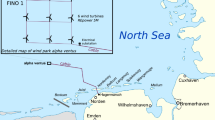Play all audios:

ABSTRACT SHOCK waves in calm air travel with a velocity that is easily calculated to include the effects of temperature, humidity and the strength of the shock front1. In turbulent air,
however, the instantaneous velocity of a shock wave is modified by local wind conditions. The shock pressure wave produces a change in the refractive index of the air2 which causes partial
reflexion of electromagnetic waves, so it has been thought possible to track the shock wave using a Doppler radar, thereby enabling its velocity to be measured and the radial wind component
to be ascertained. For this purpose Alien and Weiner3 have presented a theory to calculate the reflexion coefficient of electromagnetic waves from a sound shock front. Support for this
theory has now been obtained using the Riccati form of the wave equation as suggested by Millington4. This indicates that a typical value for the power reflexion coefficient, for realizable
shock waves at a range of a few hundred feet, is about −140 dB, assuming that the shock front is short compared with the radar wavelength. Access through your institution Buy or subscribe
This is a preview of subscription content, access via your institution ACCESS OPTIONS Access through your institution Subscribe to this journal Receive 51 print issues and online access
$199.00 per year only $3.90 per issue Learn more Buy this article * Purchase on SpringerLink * Instant access to full article PDF Buy now Prices may be subject to local taxes which are
calculated during checkout ADDITIONAL ACCESS OPTIONS: * Log in * Learn about institutional subscriptions * Read our FAQs * Contact customer support SIMILAR CONTENT BEING VIEWED BY OTHERS
SIGNATURES OF GEOSTROPHIC TURBULENCE IN POWER SPECTRA AND THIRD-ORDER STRUCTURE FUNCTION OF OFFSHORE WIND SPEED FLUCTUATIONS Article Open access 17 August 2023 WIND PLANTS CAN IMPACT
LONG-TERM LOCAL ATMOSPHERIC CONDITIONS Article Open access 25 November 2021 SPECTRAL LOCATION FOR THE UNIVERSAL SCALING REGIME IN MARTIAN ATMOSPHERIC TURBULENCE Article Open access 16
October 2024 REFERENCES * Stephens, R. W. B., and Bate, A. E., _Acoustical and Vibrational Physics_ (Arnold, London, 1966). Google Scholar * Tonning, A., _Appl. Sci. Res._, B, 6, 401
(1956–57). Article Google Scholar * Allen, C. H., _Proc. World Cong. Radio Meteorol._, 270, Boulder, Colorado, September 1964. * Millington, G., _Electronics Lett._, 1, 184 (1965). Article
Google Scholar Download references AUTHOR INFORMATION AUTHORS AND AFFILIATIONS * Department of Electronic and Electrical Engineering, University of Birmingham, J. BLOGH & D. C. COOPER
Authors * J. BLOGH View author publications You can also search for this author inPubMed Google Scholar * D. C. COOPER View author publications You can also search for this author inPubMed
Google Scholar RIGHTS AND PERMISSIONS Reprints and permissions ABOUT THIS ARTICLE CITE THIS ARTICLE BLOGH, J., COOPER, D. Method for Measuring Wind Turbulence. _Nature_ 220, 1118–1119
(1968). https://doi.org/10.1038/2201118a0 Download citation * Received: 07 November 1968 * Issue Date: 14 December 1968 * DOI: https://doi.org/10.1038/2201118a0 SHARE THIS ARTICLE Anyone you
share the following link with will be able to read this content: Get shareable link Sorry, a shareable link is not currently available for this article. Copy to clipboard Provided by the
Springer Nature SharedIt content-sharing initiative
